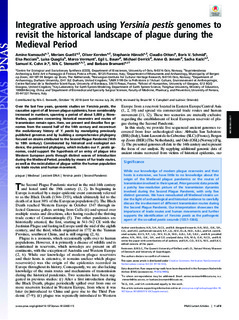| dc.contributor.author | Namouchi, Amine | |
| dc.contributor.author | Guellil, Meriam | |
| dc.contributor.author | Kersten, Oliver | |
| dc.contributor.author | Hänsch, Stephanie | |
| dc.contributor.author | Ottoni, Claudio | |
| dc.contributor.author | Schmid, Boris Valentijn | |
| dc.contributor.author | Pacciani, Elsa | |
| dc.contributor.author | Quaglia, Luisa | |
| dc.contributor.author | Vermunt, Marco | |
| dc.contributor.author | Bauer, Egil Lindhart | |
| dc.contributor.author | Derrick, Michael | |
| dc.contributor.author | Jensen, Anne Østergaard | |
| dc.contributor.author | Kacki, Sacha | |
| dc.contributor.author | Cohn Jr., Samuel | |
| dc.contributor.author | Stenseth, Nils Christian | |
| dc.contributor.author | Bramanti, Barbara | |
| dc.date.accessioned | 2019-01-22T13:48:55Z | |
| dc.date.available | 2019-01-22T13:48:55Z | |
| dc.date.created | 2019-01-07T13:34:20Z | |
| dc.date.issued | 2018-11 | |
| dc.identifier.citation | Proceedings of the National Academy of Sciences of the United States of America. 2018, 115 (50), E11790-E11797 | nb_NO |
| dc.identifier.issn | 0027-8424 | |
| dc.identifier.issn | 1091-6490 | |
| dc.identifier.uri | http://hdl.handle.net/11250/2581810 | |
| dc.description.abstract | Over the last few years, genomic studies on Yersinia pestis, the causative agent of all known plague epidemics, have considerably increased in numbers, spanning a period of about 5,000 y. Nonetheless, questions concerning historical reservoirs and routes of transmission remain open. Here, we present and describe five genomes from the second half of the 14th century and reconstruct the evolutionary history of Y. pestis by reanalyzing previously published genomes and by building a comprehensive phylogeny focused on strains attributed to the Second Plague Pandemic (14th to 18th century). Corroborated by historical and ecological evidence, the presented phylogeny, which includes our Y. pestis genomes, could support the hypothesis of an entry of plague into Western European ports through distinct waves of introduction during the Medieval Period, possibly by means of fur trade routes, as well as the recirculation of plague within the human population via trade routes and human movement. | nb_NO |
| dc.language.iso | eng | nb_NO |
| dc.publisher | National Academy of Sciences | nb_NO |
| dc.rights | Attribution-NonCommercial-NoDerivatives 4.0 Internasjonal | * |
| dc.rights.uri | http://creativecommons.org/licenses/by-nc-nd/4.0/deed.no | * |
| dc.subject | plague | nb_NO |
| dc.subject | Medieval | nb_NO |
| dc.subject | ancient DNA | nb_NO |
| dc.subject | Yersinia pestis | nb_NO |
| dc.subject | Second Pandemic | nb_NO |
| dc.title | Integrative approach using Yersinia pestis genomes to revisit the historical landscape of plague during the Medieval Period | nb_NO |
| dc.type | Journal article | nb_NO |
| dc.type | Peer reviewed | nb_NO |
| dc.description.version | publishedVersion | nb_NO |
| dc.rights.holder | Copyright © 2018 the Author(s). Published by PNAS. | nb_NO |
| dc.source.pagenumber | E11790-E11797 | nb_NO |
| dc.source.volume | 115 | nb_NO |
| dc.source.journal | Proceedings of the National Academy of Sciences of the United States of America | nb_NO |
| dc.source.issue | 50 | nb_NO |
| dc.identifier.doi | 10.1073/pnas.1812865115 | |
| dc.identifier.cristin | 1651534 | |
| cristin.unitcode | 7530,43,0,0 | |
| cristin.unitname | Arkeologiavdelingen | |
| cristin.ispublished | true | |
| cristin.fulltext | original | |
| cristin.qualitycode | 2 | |

